#ganoderma applanatum
Text



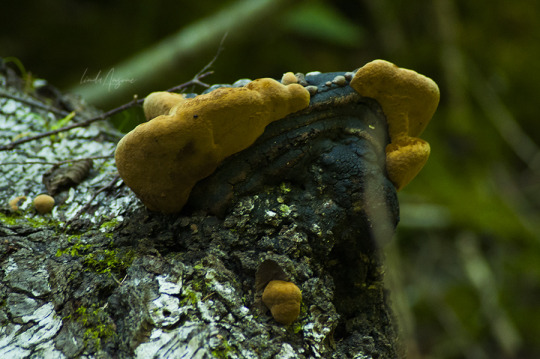


#forest#forestcore#woods#woodland#forest photography#latvia#green#nature#naturecore#nature photography#original photographers#photographers on tumblr#ganoderma applanatum
53 notes
·
View notes
Text
FOTD #011 : artist's palette! (ganoderma applanatum)
the artist's palette (AKA artist's bracket, artist's conk, artist's fungus & bear bread) is a bracket fungus in the family ganodermataceae. it occurs in almost all environments of the world !! this fungus is both parasitic & saprophytic.
the big question : can i bite it??
though it does have medicinal purposes, this fungus is mostly considered inedible !! it is sometimes cooked & used for tea, or as a flavour enhancer.
[see below cut for fun fact :-)]

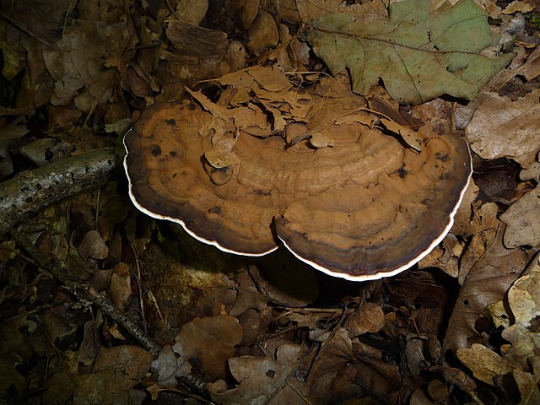
g. applanatum description :
"the ganoderma applanatum grows in single, scattered, or compound formations. it forms fruiting bodies that are 3–30 cm wide × 5–50 cm long × 1–10 cm thick, hard as leather, woody-textured, & inedible. they are white at first but soon turn dark red-brown. the upper surface of the fruiting body is covered with reddish brown conidia. brown spores are released from the pores on the underside of the fruiting body. the spores are highly concentrated, & as many as 4.65 billion spores can be dispersed from a 10–10 cm section of the conk within 24 hours. the tubes are 4–12 mm deep & terminate in pores that are round with 4–6 per millimetre. the fruiting bodies are perennial, & may persist for multiple years, increasing in size & forming new layers of pores as they grow. these layers can be distinguished in a cross section or from observation of the concentric rings on the upper surface of the fruiting body. this allows the fruiting body's age to be determined using the same method as tree rings."
fun fact : this fungus is sometimes used as a drawing medium for artists !! :-) when the fresh, white pore surface is rubbed or scratched with a sharp tool, dark brown tissue under the pores is revealed, resulting in visible lines & shading that become permanent once the fungus is dried. ^^
[images : source & source]
[fungus description : source]
"i don't have a picture, but there are one of these pretty close to my house !! it's Huge :-)"
#• fungus of the day !! •#[ganoderma applanatum]#: artist's palette :#: artist's fungus :#: artist's bracket :#: artist's conk :#: bear bread :#011#||#fungi#fungus#mycology#mushroom#cottagecore#foraging#mushrooms#earth#forestcore#nature#ganoderma applanatum#fotd#fungus of the day#artist's palette#artist's fungus#artist's bracket#artist's conk#bear bread#bracket fungus#mushroomcore
5 notes
·
View notes
Text
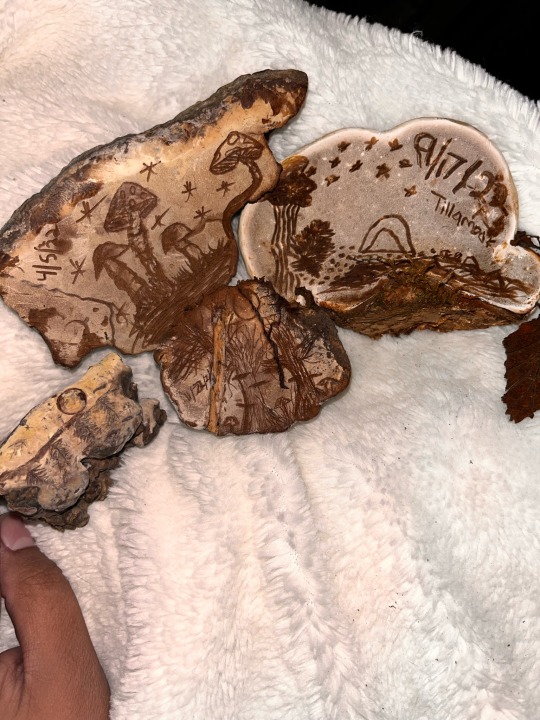
Ganoderma Applanatum aka Artists Conk is one of my favorite non-edible mushrooms! I love finding them and creating art! They bruise brown when you touch them making them Mother natures canvas🫶🏽🍄💗
0 notes
Text

Ganoderma applanatum parasitizing a beech tree
1K notes
·
View notes
Photo


Artist’s Bracket Ganoderma applanatum
#fungi#fungus#mycology#mushroom#mushrooms#cottagecore#goblincore#dirtcore#fairycore#nature#forest#forestcore#toadstool#toadstools
232 notes
·
View notes
Text



Ganoderma applanatum🍄
#tumblr chilenito#chile tumblr#photographers on tumblr#female photographers#fungi chile#esclerofilo#fungilove#bosque de chile#nature photography#nature
24 notes
·
View notes
Text

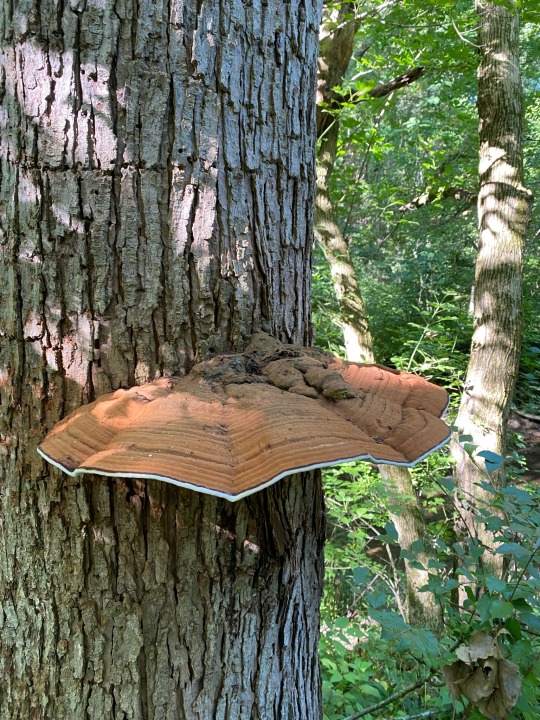

Artist’s Conk (ganoderma applanatum)
#fungi#mushrooms#nature#nature photography#mushroom photography#forest floor#mycology#forestcore#photographers on tumblr#forest#fungus#mushroom#original photographers#fungiphotography#mycelium#fantastic fungi#moss#the fungus among us#fly agaric#latvia#mine
282 notes
·
View notes
Text
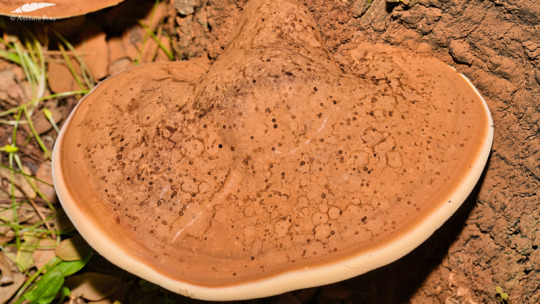

Bear Bread (Ganoderma applanatum)
Alcochete/Portugal (16/11/2023)
[Nikon D850; ∑150mm F2.8 EX DG OS HSM APO Macro with Flash Nissin Di 700A; 1/250s; 400 ISO]
8 notes
·
View notes
Text


Ganoderma applanatum | southern Oregon | ID by me (and is just a guess)
#mycology#photography#fungi#mushroom#mushroom id#my photo#mushrooms#pnw#nature#goblincore#shroom#oregon#summer find
2 notes
·
View notes
Text



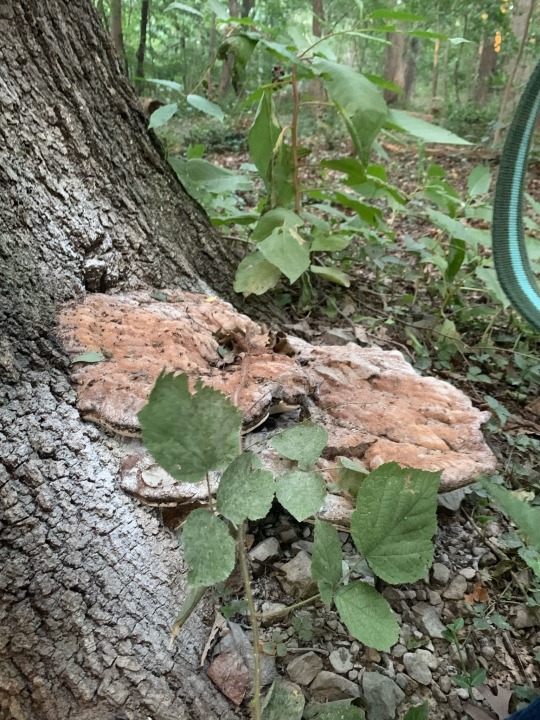
Found these huge shelf fungi growing and spreading white rot at the bottom of a few hardwood trees today. They were brown at the cap, with a white rim. Very tough and big, the larger specimen was about a foot long at its widest point. Porous at the bottom, didn’t get a spore cast. Any identification ideas? I was thinking maaaaybe artist’s conk (Ganoderma applanatum), but I’m really not sure!
#mycology#fungi#shelf fungi#mushrooms#trypophobia content#identification help#pennsylvania#ganodermataceae#polyporales
1 note
·
View note
Text
Medicinal Mushrooms in New Zealand: A Hidden Treasure of Health Benefits
New Zealand's rich biodiversity is not only a haven for wildlife but also a reservoir for Medicinal Mushroom in New Zealand, which have been gaining attention globally for their significant health benefits. This island nation is home to a variety of unique fungi, each possessing distinct therapeutic properties that have been used in traditional medicine for centuries and are now being embraced by modern science.
Mushrooms have been a staple in traditional medicine across various cultures, particularly in Asia. In New Zealand, the indigenous Māori people have also known the benefits of native fungi, using them for both nutritional and medicinal purposes. Today, the interest in these natural remedies has sparked scientific research, aiming to validate and harness their health-promoting properties.
Among the notable species found in New Zealand, the native mushroom Cordyceps robertsii is particularly fascinating. Traditionally known for enhancing energy and stamina, this fungus grows on insect larvae, converting its host into a fruiting body. Its properties are studied for potential benefits in boosting energy and immunity, making it a subject of interest for athletes and those seeking to enhance physical performance.
Another significant species is Lentinula novae-zelandiae, a close relative of the well-known shiitake mushroom. Packed with vitamins, minerals, and antioxidants, shiitake mushrooms are renowned for their ability to support immune function and reduce inflammation. The New Zealand variety shares these beneficial traits and adds a unique local twist to the global shiitake market.
New Zealand's Ganoderma applanatum, commonly known as the Artist’s Conk, is a type of reishi mushroom. In various cultures, reishi is dubbed the "mushroom of immortality" for its health benefits, including boosting the immune system and potentially fighting cancer. The presence of this mushroom in New Zealand provides local researchers and wellness enthusiasts an opportunity to explore its unique variants and properties.
Research on these mushrooms in New Zealand is still in the early stages, but the potential is immense. Scientists are exploring how these fungi can be cultivated sustainably and how their active compounds can be extracted effectively. This research not only aims to bolster the local economy by tapping into the growing global market for medicinal mushrooms but also to provide scientific backing for traditional uses.
The sustainable cultivation of medicinal mushrooms also aligns with New Zealand’s environmental ethos. The country’s clean, green image supports the organic cultivation of these mushrooms, ensuring that they are free from pesticides and other contaminants. This practice not only enhances the purity and efficacy of the mushrooms but also ensures that their use is sustainable and environmentally friendly.
Moreover, the increasing popularity of medicinal mushrooms has led to the growth of local businesses specializing in their cultivation and sale. These enterprises often collaborate with local researchers to refine cultivation techniques and extract maximum medicinal value. This synergy between traditional knowledge, modern science, and commerce is paving the way for a new, health-focused industry in New Zealand.
For More Info:-
Organic Cordyceps Mushroom Powder
Organic Reishi Mushroom Powder
0 notes
Photo
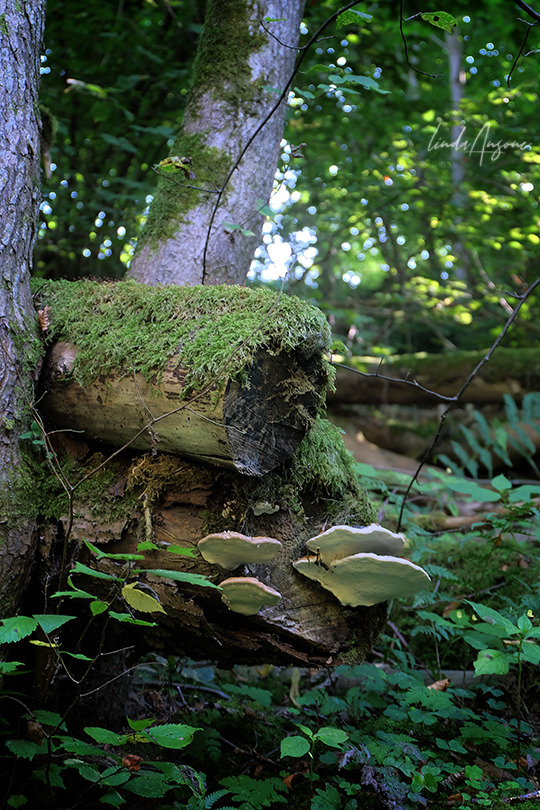
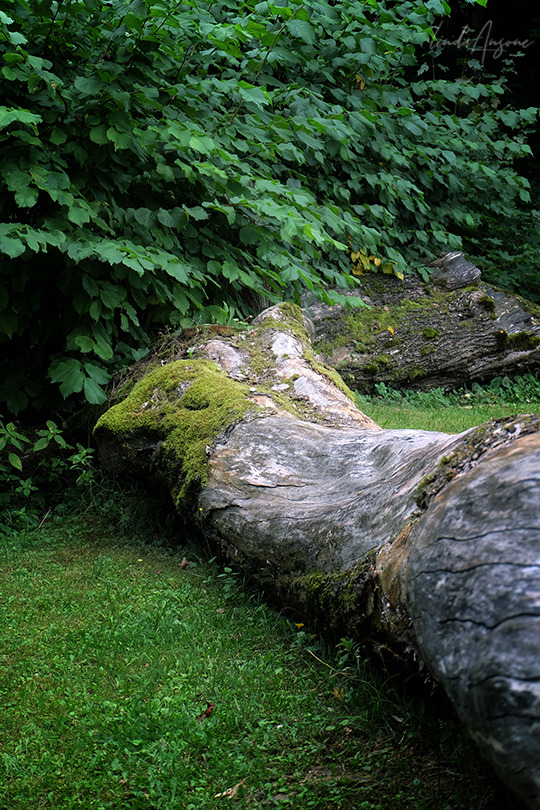
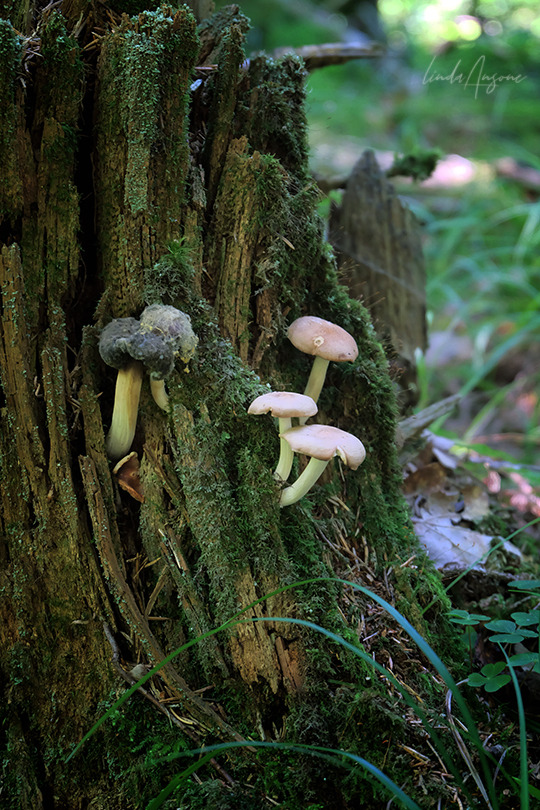

#woods#forest#forestcore#moss#mushrooms#fungi#ganoderma applanatum#latvia#woodland#original photographers#nature photography#photographers on tumblr#nature#1k#2k#3k#4k#5k#6k
7K notes
·
View notes
Note
Going off the inkcap into ink ask, apart from food and ink, what else can I do/make with fungus?
here's a little list !! :-)
with artist's conk brackets, you can use the underside for drawing as - when the flesh is scraped away - there is a brown layer underneath. when it dries & hardens the art will keep for a long time :-)
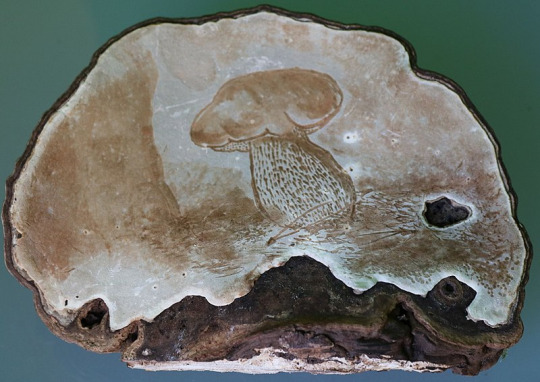
mushrooms that contain psilocybin are used as psychedelic drugs - the most potent is p. azurescens.

many different fungi can be used as dyes -
many moulds are used in food manufacturing processes, for example when making cheese or yoghurt.
you can purchase mycopesticides to control pests.
yeast is a fungus that we consume every day through beer, wine, soy sauce & bread products. :-)
that's about all i've got for you, luna !! <3
#• askbox replies: •#(ask : luminousmoon21)#[ganoderma applanatum]#: artist's palette :#: artist's fungus :#: artist's conk :#: artist's bracket :#: bear bread :#||#fungi#mould#mold#fungus#mycology#[psilocybe azurescens]
55 notes
·
View notes
Text


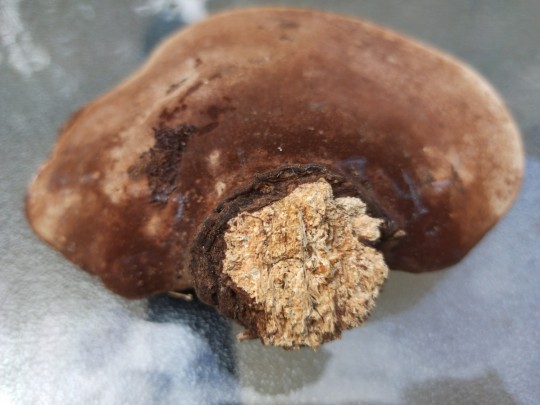

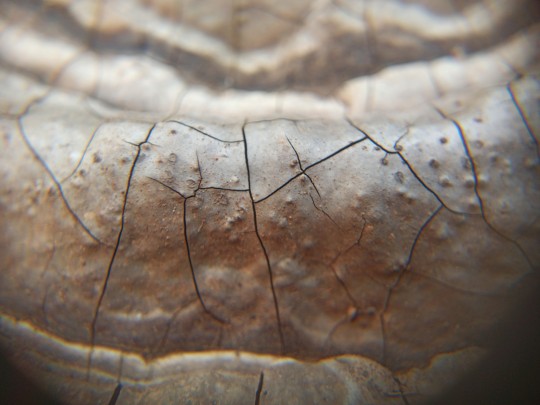
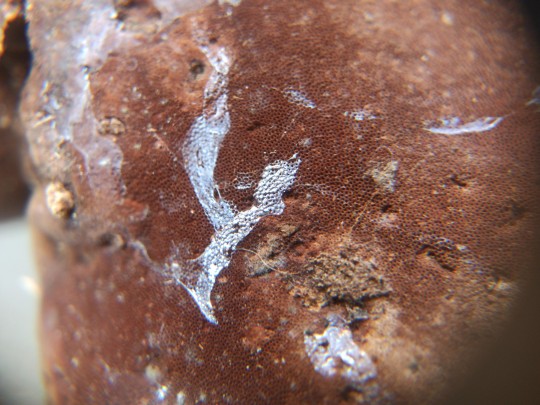


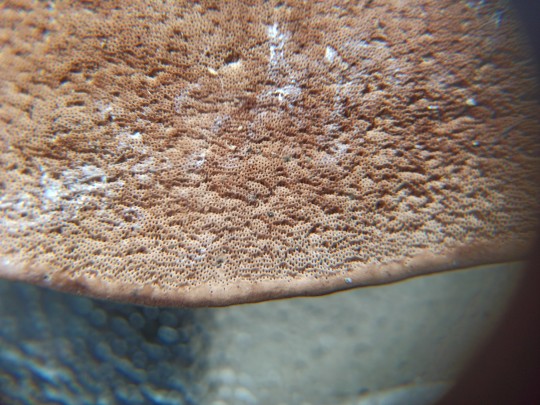
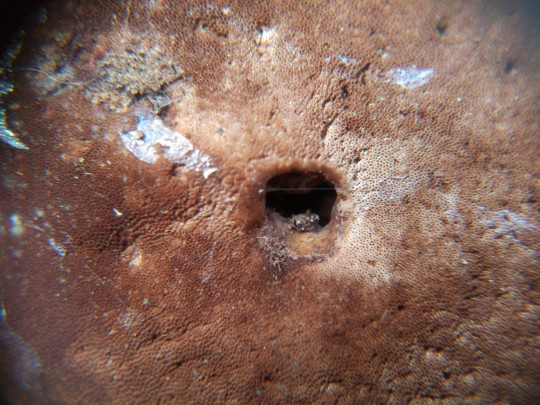
Ганодерма — род грибов - трутовиков из семейства ганодермовые.
Ganoderma is a genus of polypore fungi in the family Ganodermataceae that includes about 80 species. Ganoderma can be differentiated from other polypores because they have a double-walled basidiospore. They may be called shelf mushrooms or bracket fungi.
Division:Basidiomycota
Class:Agaricomycetes
Order:Polyporales
Family:Ganodermataceae
Genus:Ganoderma
Род ганодерма делят на две секции: Ganoderma с блестящей шляпкой (подобно Ganoderma lucidum) и Elfvingia неблестящей поверхностью (подобно Ganoderma applanatum). Ganoderma походить від грецького ganos / γανος «яскравість, блиск», звідси «блискучий» та derma / δερμα «шкіра».
For centuries, Ganoderma species have been used in traditional medicine in many parts of Asia. Ganoderma are used in China and Japan for the treatment and prevention of hepatitis, hypertension, chronic bronchitis, bronchial asthma, hyperglycemia, rheumatism, connective tissue and oesophageal cancer (a dangerous tumor with epithelial cells), arthritis, tuberculosis and many other diseases. Ganoderma species are also used as functional food to prevent and to treat a lot of diseases including anorexia, arthritis, asthma, cardiovascular problems, diabetes, gastritis, hepatitis, hypercholesterolemia, hypertension, insomnia, migraine, nephritis, obesity, and tumorigenesis, amongst others.
Northcross Drive, Oteha, Auckland 0632 7PJC+M46 Auckland
-36.7183470, 174.7202810
наземные грибы трутовики
0 notes
Text
JoF, Vol. 9, Pages 1023: How Different Molecular Markers Estimate the Diversity of European Species of the Ganoderma Genus
Based on published anatomical-morphological and ecological characteristics and phylogenetic evidence, six species of the Ganoderma genus are known to occur in Europe, namely, G. applanatum (Pers.) Pat., G. adspersum (Schulzer) Donk, G. pfeifferi Bres., G. resinaceum Boud., G. carnosum Pat., and G. lucidum (Curtis) P. Karst. Molecular markers (DNA sequences of selected genes or intergenic spacers) r#evolutionized our view of fungal variability. Every one of the four most frequently used molecular markers (ITS (internal transcribed spacer) and partial sequences of LSU (#rRNA large subunit), tef1-α (translation elongation factor 1-alpha), and Rpb2 (#RNA polymerase II second largest subunit)) provides a different view on the variability of European species of the Ganoderma genus. Both the lowest intraspecies variability and the best species differentiation (interspecies divergence) were observed for the LSU marker, and based on our data, this marker could be recommended for identification and species delineation in European Ganoderma spp. The sequences of the most frequently used ITS marker were unable to discriminate between G. lucidum and G. carnosum, and in general, this species pair showed the lowest interspecies divergence using all markers tested. Surprisingly, up to now, hidden variability has been detected in several Ganoderma spp., indicating the existence of possible cryptic taxa within the European Ganoderma morphospecies. https://www.mdpi.com/2309-608X/9/10/1023?utm_source=dlvr.it&utm_medium=tumblr
0 notes
Text
Teachings from the Medicine Den [1/?]
New blabbers! Featuring medicinal plants native to the Pacific Northwest, specifically the WEST side of the Cascade Mountains! My AUs/Fanclans are set here, simply because it's the region I'm most familiar with!
Herb info is below the cut!
Alumroot and Artist's Conk
Alumroot (Heuchera glabra)
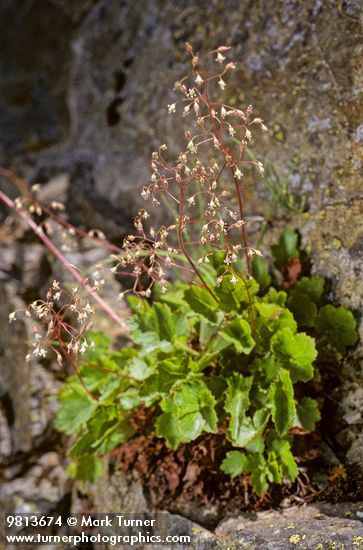
[x]
Description
5-lobed leaves attached to stout, scaley rhizomes via a long, hairless leaf stalk. Sticky hairs may cover the undersides of the smooth-topped, deeply-toothed leaves. Tall, thin, wiry reddish stems with 1 or 2 leaves that are much smaller than the basal leaves that have sprays of small, white, 5-petalled flowers on branching stalks
Used Parts
Roots, Leaves
Can be found...
Wet and rocky places from the coast to woodlands. Can be found in moist crevices, rocky meadows, stream banks, and near misty waterfalls
Harvest Season
Roots: Leaf-fall after the leaves begin to die back.
Leaves: Any time before leaf-fall
Uses
- Roots steeped in water held in mouth/throat to help with sore throats.
- Roots steeped in water swished in mouth tightens inflamed gum tissues
- Roots steeped in water drank to relieve diarrhea or reduce gastrointestinal inflammation
- Powdered root or crushed leaves applied topically stops bleeding from wounds
-------------------------------
Artist's Conk (Ganoderma applanatum)
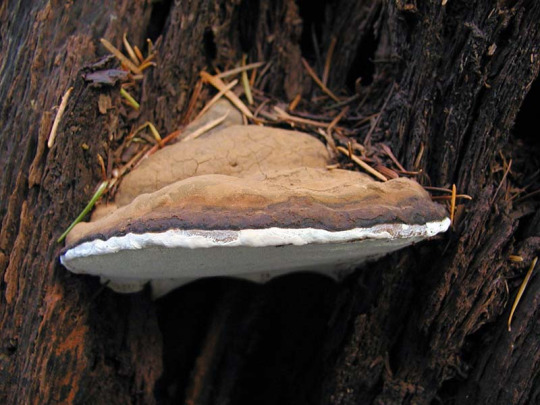
[x]
Description
Light brown with wide, rounded, white lips at their front edges. Fan-shaped/semicircular fruiting bodies with dense, woody, cinnamon-brown, corky flesh emerge from dead trees to decompose.
Used Parts
Fruiting body
Can be found...
Grows mostly on hardwood trees, especially on the decomposing wood of Douglas fir trees; perennial
Harvest Season
Leaf-fall rainy season; prepare as soon as possible
Uses
- Steeped in water and drank to lessen general inflammation, reduce the size of and inhibit the growth of cancerous tumors, stimulate white blood cell activity to boost immunity
- steeped in water and drank to aid digestion, settle upset stomach, and dry up excessive mucus discharge from the lungs
- Steeped in water and drank to calm the nervous system
PSA: Do NOT use these medicinal herbs without doing THOROUGH research on them! I have merely condensed down some information I have from a medicinal plant book and have not included any sort of HUMAN reference! This is simply for FICTIONAL CATS! NOT HUMANS!
#Teachings from the Medicine Den#Healers#Medicinal Herbs#Artists Conk#Alumroot#snini's ocs#snini9sWCAU#ancientroots#AncientRootsAU#BlizzardstepsGuilt#OceansRequiem#FFMistClan
1 note
·
View note